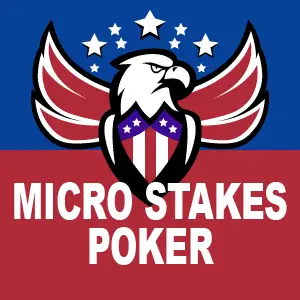Fast Track To Success – Lesson 5

Micro Stakes Poker (5)
- Poker is a game of understanding and playing the odds
- Even newer players need to get a firm grasp on the way odds changes things
- There is always money already in the pot which can make a big difference
Understanding Poker Odds Is A Big Part Of The Game
Poker is a game of odds. The better you understand the odds of a given situation, the more likely that you will be successful at playing it. So at this point I want to talk a little about that since it’s really the foundation of pretty much everything we do. Now I’m using the term odds in the broadest sense here, meaning that it’s not just our chances of having the best hand, it’s also the chances of an opponent having a certain strength of hands, the money in the pot in relation to what we’re looking to contribute, and also the odds he or she will react a certain way to a given action by us such as the chances they will fold if we bet.
One of the key elements in looking at odds is how the odds that the money in the pot or the money we may expect will be there eventually will affect our decisions. You have probably heard of terms like simple pot odds, or implied pot odds, or maybe even reverse implied odds. These are all pretty basic to learning the game and while your understanding of them will deepen as you progress, you’re going to need to gain at least a decent understanding of them to have much of an idea at all what you’re doing.
Simple Pot Odds

So let’s start with simple pot odds. As opposed to implied odds, where we look to predict how much money will be in the pot at a later point in the hand, with simple odds, we’re just looking to either use what’s in there now, or to add in what an opponent would need to put in to determine our pot odds if called. This is always the starting point for odds calculations and it’s only when you understand simple pot odds and how they are calculated that you can move on to more complicated calculations.
There are two elements to any odds calculation, which are what we feel are our chances of winning the pot, and the odds that the pot is laying us. So for instance, we may feel that we have an even chance of winning, someone bets into us, and it costs us $1 to call. However, there is our opponent’s $1 in there plus another $1 that was there prior to the bet. So if we win the hand, just counting this money that is in there now, we win $2, and if we lose we only lose $1.
So we take the amount that we can win if we have the best hand, which is $2, and the amount that we lose if we don’t win, which is $1, and then we can say that the pot is laying us 2:1 odds. So as you can see this ratio is money won to money lost, and you will almost always see pot odds expressed this way.
Figuring Out Simple Pot Odds
So among the things we can do with this is figure out what chances we need to win in order to make staying in the hand profitable. So to figure this out, what we need to do is add the two up and then take the second number and divide by this total. In our example, we have 2:1 so added together this comes to 3. So we take the second number, which is 1, divided by 3, which is 0.33. So this number is the percentage of times we’ll need to win this hand to break even, which in this case is 33%.
We often don’t have a very accurate number as far as how often a certain hand will win the pot, and although as we get better and more experienced our estimations on this will improve, it will always be just an estimation. So our starting point here should be to first go with what we know and then look to figure out things from there. This simplifies our decisions, and in our example for instance we don’t need to ask ourselves what our chances are to win, we only need to ask whether it’s at least 33%. If the answer is yes, we continue on, and if it’s no, we fold.
We Need To Think About The Odds With Every Decision We Make
This thinking is involved right from the beginning of the hand, which is the reason why we want to look to be selective with our starting hands. Poor starting hands have too low of an expectation of profit due to their too low winning percentage, and even the pot odds don’t help them enough. Now while we don’t want to sit down and try to figure out the pot odds of a starting hand, as that would be too complicated especially for newer players, and this involves looking at the overall pot odds or implied odds as well, it’s good to keep in mind that pot odds play a role in all of our decisions at the table.
Now these decisions will come down to us either having positive or negative value equity. Value here means our expectation of making money overall should the hand be shown down, as opposed to fold equity which is our expectation of profit if we end up taking the pot down prior to showdown.
So there are some cases where we don’t have enough value equity to continue, but combined with fold equity, it may be a profitable decision to bet or raise. For instance you may have heard about the semi-bluff, which involves not having a hand good enough to look to show down, but when we factor in our chances of taking the pot down, the two added together make the play profitable. We’ll talk about this in more detail a little later on, and at this point I want to make sure you know what I mean by value equity, or as it is often referred to, simply “value.”
Pot Odds In Action
If we are the ones doing the betting, we are going to want to calculate our pot odds if called. For instance, there is the same $1 in the pot, and we’re the ones betting the $1 now. The pot odds right now are 1:1, as we’re risking $1 to make $1. However, this is a fold equity calculation, meaning that this will only apply in reference to our opponent’s tendency to fold. So if he folds half the time here, half the time we make $1, and the other half we don’t make an instant profit, although there’s also the chance that we can win when called as well, although we’re not even looking at that right now.
So one of the things that we know from this is that if the opponent folds more than half the time, we know right there that betting is profitable, without even having to look at what value equity we may have. So this could be a stone cold bluff and it will be profitable to make as long as we get enough folds. Given that players tend to fold quite a bit, it’s not hard to see that this should be a regular weapon in our arsenal.
Pot Odds Can Make It Profitable To Even Play Hands That Are Behind
However, for purposes of value equity, we need to figure out what our pot odds are when called. So when our opponent calls us, there is now $3 in the pot, and our profit is once again $2. This is a little different to calculate than when we’re bet into, and in this case you add the call to the pot. However, you can do the same thing with the other example, there’s $2 in the pot, you take what it costs you to call divided by what the pot will be when you put it in there. When you’re doing the betting, you divide your bet by the pot size when both you and your opponent put your money in.
So in this case, we have once again 1 divided by 3 which turns out to be 0.33 or 33%. So this may seem a little counter intuitive, but let’s say that you know that you only have a 40% chance to win the pot, and your opponent knows he’s the favorite so he’s never folding here. Should you bet? Well the answer surprisingly is yes, and definitely yes.
The Money Already In The Pot Changes Things
However, if we use the same calculations for our opponent, it will turn out that it’s correct for him to call this bet, as it is profitable for him to do so. So we’re saying that it’s both profitable for you to bet, without any fold equity whatsoever, and it’s also profitable for your opponent to call. How can this be?
The reason this is the case is that there is money already in the pot and both you and your opponent can be in a position to claim part of it as profit overall. So for instance if we repeat this scenario over 100 times, you’ve won a piece of this dollar in the pot overall, and your opponent has as well, although his piece is bigger than yours in this case.
So you can see that it’s often a good idea to bet even if you’re not even the favorite to win the hand, although you need to have enough of a chance to win so that it’s not an unprofitable play. If you only had a 25% chance to win, for instance, then you’d be losing money with the play and unless you have enough fold equity, you should just check and look to fold in this spot.
So I’m going to continue the discussion of pot odds in the next session, where we’ll look at adding in fold equity here and also look at the bigger picture of implied odds.
Micro Stakes Poker – Fast Track to Success
- Fast Track To Success – Lesson 1
- Fast Track To Success – Lesson 2
- Fast Track To Success – Lesson 3
- Fast Track To Success – Lesson 4
- Fast Track To Success – Lesson 5
- Fast Track To Success – Lesson 6
- Fast Track To Success – Lesson 7
- Fast Track To Success – Lesson 8
- Fast Track To Success – Lesson 9
- Fast Track To Success – Lesson 10
- Fast Track To Success – Lesson 11
- Fast Track To Success – Lesson 12